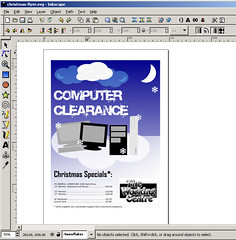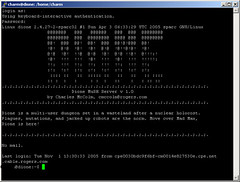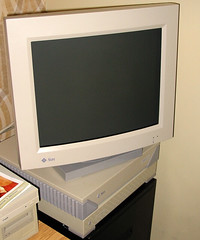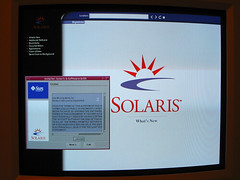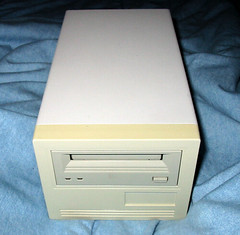Thursday, December 08, 2005
A SOHOWare experience
I finally broke down and burned a copy of the multi-megabyte driver from SOHOWare, and after a couple more false starts, and needing to know what path things were stored at, we managed to get the driver working. In short, it took A LOT of effort!
Now I know I'm comparing apples and oranges when comparing Windows 95 and Linux, but only slightly. The machine in question wasn't capable of running Windows XP, at least not well. Had I put Debian GNU/Linux on the machine it would have picked up the SOHOWare card right away with a newer kernel. People always talk about how *easy* things are in Windows, forgetting minor irritants like the experience I just mentioned above. My point of all this is that Linux does have better hardware support than Windows. If you consider how badly XP would run on such a machine (64MB RAM), and the fact that installing the 95 driver is a royal PITA unless you waste a CD-R, installing a Linux distribution like Puppy Linux or Debian GNU/Linux seems like a breeze.
Resources
Friday, November 25, 2005
Vanquishing technology
 If you've been following my web log, you know I have an almost fanatical interest for unusual hardware. It seems that fanaticism extends to non-computer hardware too. And while I might be able to buy a (once) $60,000 computer on eBay for $20CDN, the piece of hardware I got turned on to this evening would never sell for anything remotely as cheap as the Sun Ultra 2.
If you've been following my web log, you know I have an almost fanatical interest for unusual hardware. It seems that fanaticism extends to non-computer hardware too. And while I might be able to buy a (once) $60,000 computer on eBay for $20CDN, the piece of hardware I got turned on to this evening would never sell for anything remotely as cheap as the Sun Ultra 2.I was watching the modern version of The Italian Job, and decided to look up "Handsome Rob's" thrill machine, the Aston Martin Vanquish. Baby, the Vanquish is one dream machine! It's capable of burning up the road at over 200mph, does 0-60 in less than 5 seconds, even comes digitally, and electronically customizable with the owner's name plate - we're talking dream machine!
I've watched this version of The Italian Job a few times, and so much attention is focused on the Mini Coopers that the rest of the cars barely have any chance for limelight. Aston Martin's web site is pretty slick, but I was somewhat annoyed when I visited the web site of the Toronto dealer for AM; when I brought up the page for the Vanquish the site played the theme from James Bond. If you're trying to project class, playing the theme song from James Bond is not the way to do it.
The V12 in the Vanquish reminded me of this site I came across this morning, a V12 made almost entirely out of paper! Cool hack!
Resources:
- Aston Marton (requires Flash)
- Techeblog paper V12 article
Wednesday, November 16, 2005
Camstreams and lftp
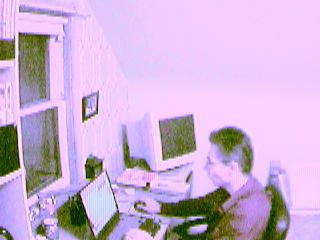
In my last post I alluded to a web-cam project I was working on. I had hoped the software I was using for Linux, Camstream, was capable of uploading to me site, and there appeared to be facilities to do so - the only problem was that all the images it uploaded had a zero-byte size; in other words the upload didn't work properly. Luckily, Camstream did save the image perfectly to the hard drive, which meant I could use a little scripting to auto upload it to my web site.
I'm no hard core shell script hacker, this is just my solution to a problem; I'm sure there are plenty of better solutions, but this one works for me, so I thought I would share:
First I needed to find a ftp program that I could script. I chose lftp because it seemed like the easiest program to script, you just run lftp with the -f switch and the name of your script. For example, if your script is called uploadimage you'd get cron to run:
/usr/bin/lftp -f /home/username/uploadimage
Where /home/username is the path to where you put your script. The second job was to write a script that would upload the image. This was actually just a few lines of script:
open -u myusername,mypassword my.ftp.server.address
rm /img/videocamera.jpg
put -c -O /img /home/myusername/videocamera.jpg
quit
It's a very simple script. The first line connects to the ftp server at my.ftp.server.address. Line 2 removes the existing image. Line 3 puts the new image with a switch to overwrite the old image if it exists. And the last line ensures lftp quits.
I tested the script before putting it in a cron job by typing:
lftp -f /home/myusername/uploadimage
When it worked I put the script into a cron job:
0,5,10,15,20,25,30,35,40,45,50,55 * * * * /usr/bin/lftp -f /home/myusername/uploadimage
The 0,5,10,15... part ensures the cron job runs every 5 minutes. The other four stars ensures the job runs every day of the week. Now, I probably should have mentioned how to edit a cron job in the last post, and before I posted the line above, but it's been a long day and I'm still trying to wind down, so here it is: as root type:
crontab -u myusername -e
Substitute the user name you use on your local Linux system, not the username you would use on your ftp site.
The last element was creating a simple html page to display the image videocamera.jpg. I won't explain the mechanics of HTML here, but I'll mention that I borrowed some javascript code, and hacked it to refresh the web page itself about every 3 minutes.
Resources:
Please note that if the camera feed is black it's probably dark out, or I'm chilling watching a movie. I still have a way to go with this project and will probably run the images through imagemagick, but that's another post...
My first "real" computer was an IBM PC/XT. While our family had a Commodore 64, I don't think anyone would argue that it was anything but a game machine, at least not the way we used it. Since the XT was my introduction to the Personal Computer market, I got pretty use to IBM and Microsoft DOS (Disk Operating System).
I've never been much of a code hacker/junkie, but I did slap together quite a few batch files to get DOS to save me a few steps. Under Linux you can also script things. Most scripts begin by pointing to whatever shell you're using. I would imagine that a good 60% of the Linux community is using good old Bash. An example bash script:
#!/bin/bash
echo "Shell scripting is fun"
Then you would change permissions on the script to include execute permission, at least for yourself. Be wary of arbitrarily running shell scripts which you don't know the purpose of - you don't want to run a rootkit.
chmod ug+x myshellscript
Now the user who created myshellscript has permission to run it, as does anyone who belongs to the same group as the user.
So what good is all this? When combined with another tool, cron, you can schedule your script to run at certain intervals. I've set up a cron job that runs a script which connects to a ftp server and uploads a web cam image at certain intervals.
I won't go into the details of cron because this post is long enough, but the links below should help.
Resources:
Cheers until next time!
Monday, November 14, 2005
UltraSparc T1

Sun Microsystems has unveiled a new processor in its UltraSparc line of processors, the UltraSparc T1, codename Niagara. The chip boasts 8 "computing engines" and according to an article on ABC News, uses about half the power of traditional processors.
I hope this improves sales of Sun machines. I'd like to see Sun stick around. Sun has made some pretty sweet machines, and it's nice to have an alternative to the Intel/AMD architecture, even if the machines are a little expensive.
Go Sun, go!
Resources:
Sunday, November 13, 2005
Ultra 2 almost $60k!
The Ultra 2 Creator 3D 2200 comes with a pair of 200-MHz UltraSPARC CPUs, 256 megabytes of RAM, a 4 gigabyte hard disk, and 20-inch monitor. It costs $59,995. With a multi-threading, multi-processing SunSoft compilers, the Ultra 2 generates 332 SPECint92 and 505 SPECfp92, the highest recorded floating-point SPEC92 results.
It sounds like I may have got even more of a bargain than I thought!
Resources:
Saturday, November 12, 2005
Screenshot of Fedora Core 4 with extras
 One of the things I love most about Linux is how customizable it is! While the same is somewhat true of Microsoft Windows, you usually have to buy add-ons like Stardock Window Blinds. The see through calendar is gdeskcal, the music player just below is a minimized version of xmms, and I have The Gimp opened.
One of the things I love most about Linux is how customizable it is! While the same is somewhat true of Microsoft Windows, you usually have to buy add-ons like Stardock Window Blinds. The see through calendar is gdeskcal, the music player just below is a minimized version of xmms, and I have The Gimp opened.Resources:
More pictures soon.
Thursday, November 10, 2005
Sun Ultra Enterprise 2 photos
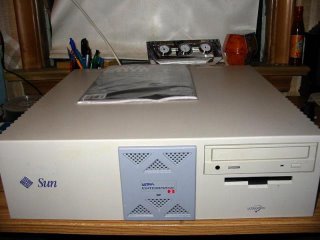 The Sun Ultra Enterprise 2 I ordered on eBay arrived yesterday, 2 days after it was shipped - amazing! Unfortunately the box seems to hang at the beginning of the memory count. I suspect the problem is the RAM configuration. I read somewhere that the minimum RAM configuration would be 128MB of RAM because the RAM is installed 4 DIMMs at a time, with 32MB RAM the minumum (4x32MB=128MB). My machine has 8 sticks of RAM, but shows 64MB at the top. I won't speculate beyond this, but I may have some other RAM coming.
The Sun Ultra Enterprise 2 I ordered on eBay arrived yesterday, 2 days after it was shipped - amazing! Unfortunately the box seems to hang at the beginning of the memory count. I suspect the problem is the RAM configuration. I read somewhere that the minimum RAM configuration would be 128MB of RAM because the RAM is installed 4 DIMMs at a time, with 32MB RAM the minumum (4x32MB=128MB). My machine has 8 sticks of RAM, but shows 64MB at the top. I won't speculate beyond this, but I may have some other RAM coming.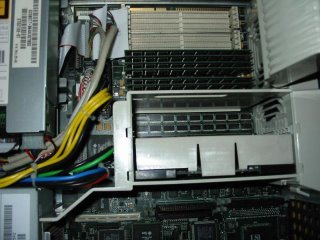 My machine has a single 200MHz UltraSparc processor. It's possible that it might take up to a 400MHz processor, but even if it doesn't, the machine is still dual processor capable. I was amazed at the internals of this machine, everything is packed pretty tighly. I couldn't even see a spot I might stick a hard drive other than under the floppy bay. The Ultra 2 is a heavy beast! I'm somewhat surprised I only paid $14US for shipping, considering how fast the machine arrived, its packing, and weight.
My machine has a single 200MHz UltraSparc processor. It's possible that it might take up to a 400MHz processor, but even if it doesn't, the machine is still dual processor capable. I was amazed at the internals of this machine, everything is packed pretty tighly. I couldn't even see a spot I might stick a hard drive other than under the floppy bay. The Ultra 2 is a heavy beast! I'm somewhat surprised I only paid $14US for shipping, considering how fast the machine arrived, its packing, and weight.
Tuesday, November 08, 2005
Why the Iriver H10 sucks, and sucks BAD!
The H10's biggest problem is it's reliance on MTP, Media Transfer Protocol, and on Windows Media Player 10. The first part of this equation, MTP, eliminates anything non-Microsoft. This means MAC and Linux users are SOL if they want to connect their iRiver H10 to their boxes. The second part of the equation is the hook into Windows Media Player 10. According to MSDN, the MTP driver can run on Windows 98 through to XP, but iRiver have chosen to impliment it on Windows XP with SP1 installed and Windows Media Player 10. I had these all installed and my player still didn't work until I did all updates, and updated to SP2.
Another disappointment was the battery life. It's advertised as up to 12 hours. Realistically, it's more like 4, and that's not using it every day.
The H10 also has some major design flaws. The power button is located on the side of the player. Every time I try to slip my player into the included "condom" case I end up shutting off the player in the middle of a podcast. The power would have been much better on the top where the lock is. I also don't like the placement of the fwd, play, and back buttons, with the case on I often reset a podcast.
On to the software side. What can I say, except I hate Windows Media Player 10.
Why couldn't the dummies at iRiver have just made this another hard drive mp3 player instead of selling out? Yeah guys, the image of Bill holding your product says it all. And the condom case might appeal to some, but it really has limited functionality, and in the case of the H10, it hampers proper use.
Resources
- MSDN info on MTP
- IRiver Link excluded because I don't recommend this product at all!
Wednesday, November 02, 2005
Synoptics LattisHub 2803
My Synoptics hub has been put to use under Titan, my main desktop workstation; the hub keeps the tower off the carpet -- in other words it's not really in use.
I decided to do a little investigation and discovered that the Synoptics hubs have a few problems. Apparently they don't like BOOTP much. Microsoft encourages Synoptics owners to upgrade the firmware on the hub, and to use TFTP.
Surprisingly, I couldn't find a Synoptics, or Bay Networks, apparently a newer name, on Google. Everything I read leaves me to believe that they were swallowed by Nortel. If you know, I'd like to know.
Resources:
Inkscape inspiration
Inkscape is a .svg vector art program that lets you do some pretty dynamic graphics - even if you don't have a lot of drawing skill. The computers, clouds, everything except the Working Centre logo were all created for this image in roughly 1/2 hour.
Of course, Inkscape is open source!
References:
Tuesday, November 01, 2005
Getting more work done at work!
At work we primarily use Windows, though we do have quite a few Linux boxes. For reasons of support and compatibility I've been told to stick with Windows on my primary box. (Which also shares (samba anyone) a printer). Eventually I probably will move to an all Linux box, but I have to prove it can be completely compatible, and I'm busy enough with other details to get everything working.
It may seem useless to have a shell at work, but if you can't install software at work, or need to use software like figlet, a program that creates neat ascii fonts, SSH comes in real handy.
Resources:
Monday, October 31, 2005
Shedding a little light on the Sparcstation 5
There are actually 2 machines in this photograph. On the bottom is a currently inactive Sparcstation 1. The Sparcstation 1 is due for an upgrade, from a 250MB hard drive to a 2.1GB hard drive, but I haven't bothered because I don't have enough power outlets to run it, so there's no point at the moment. On top is Dione my Sparcstation 5. Dione has the following specs:
224MB RAM
9.1GB 10,000 RPM SCA SCSI Hard Drive
10/100MB/s Hme NIC
10MB/s Lance onboard NIC
Sun GDM20D10 Monitor with remote
External TDC SCSI Tape Drive (2GB)
External 12x Lacie CD-ROM
External TDC 10GB Raid Array (4 drives)
Sunday, October 30, 2005
Slowlaris 9 on the Sparcstation 5
The Solaris web startup is really quite nice, and I would imagine on a Sun Blade it would rock, but not on this machine.
Installing Solaris took the better part of an evening. There was a lot of data, and transfer was slow on the 12x CDROM. Once installed, I played with CDE (Common Desktop Environment) for 20 minutes or so before I realized that I would just prefer the text interface of Debian GNU/Linux, and all the software that comes with it. Solaris is pretty, just don't try running CDE on a SS5.
Currently Sun is touting Solaris 10. You can get version 9 and earlier versions by following the Solaris link in the resources, Choosing Downloads from the top navigation menu, selecting see all, Operating Systems, and Solaris Operating Systems.
Resources
The mysterious SCSI tape drive.
Armed with Google and Ebay I set out to find out more about the mysterious SCSI drive whose only identifying marking was a pen-scribbled TDC Model C1536. Scouring google turned up nothing for the complete result, but I found quite a few interesting matches on "C1536" which, although they were for internal tape drives, seemed to confirm that the drive takes 2/4GB DDS/DAT tapes. The sites also confirmed the drive is SCSI-2 (Fast).
Digging a bit deeper I discovered that the company that makes the drives is indeed alive and well, thriving in fact, but they've long dropped supporting the TDC Model C1536. In fact there seems to be no mention of it anywhere, which is one of the reasons for this post: if you own one of these drives, you'll probably want to stick around for future posts concerning the drive and any success with backups and tapes. Oh yeah, the company is now called Tandberg Data. I would imaging the C in TDC was Corporation. They seem to be thriving as a backup solution provider to the high end market. At the low end, well, there's this blog to start. Unfortunately there seems to be little other information unless you consider this drive and the similar internal Compaq/HP drives to be the same beast. More on the mystery drive in another post.
Resources:
- Tandberg Data
- Emag Solutions - tape solutions
- Google Canada
- Ebay Canada
Friday, October 28, 2005
PriceWaterHouseCoopers switch from Windows to OpenBSD
What I found most interesting about the article, which can be found in its complete state at Computerworld, is the following quote:
"We saved seven salaries worth over one year. It was so dramatic they gave me a big raise and I was promoted from system administrator to IT manager."
The manager did admit that half the machines still ran Windows, but it's clear from the article that OpenBSD was responsible for alleviating a lot of the headaches PWC was having.
Wednesday, October 26, 2005
Sun specs
That said, I did managed to spend some time piecing together all the parts I bought off eBay for my Sun Sparcstation 5 (SS5). I originally bought 3 Sparcstation 5's at $3.00 CDN each. The source I bought them from sells only "AS IS" parts, so I knew the best way to get 1 working machine was to buy as many as I could and use the parts from all of them to build one machine. Between the 3 machines I cobbled up enough memory to put 224MB of RAM into one machine. The big missing links were the Sun Type 5 keyboard and a CD-ROM to simplify the install process. I probably could have booted from the network card and did a network install, but it was easy enough to find a SCSI CD-ROM that was compatible. Unfortunately the CDROM doesn't sit well in my case, so I used it enough to install Debian GNU/Linux SPARC, then I removed the CDROM. There are CDROM's that fit well in this case, I'm just too cheap to spend any more money on a 110MHz computer, even if it uses the SPARC architecture.
The Sparcstation 5 comes in a number of models that range from 70MHz to 170MHz, but the 170MHz version uses a different processor which Obsolyte claims has issues with Linux. The next best machine in the line contains the 110MHz processor. I was lucky to get a hme (Happy Meal) network card in one of the Sparcstation 5's. Normally the onboard "Lance" network card runs at 10MB/s. The hme card runs at 10/100MB/s, which is great because I also bought a 9.1GB, 10000 RPM SCA hard drive. I was in a bit of a rush this morning and didn't want to set up my external USB drive so I just set up vsftpd and transfered the files to the sparc, then to the windows partion of my notebook. I still haven't managed to get the files (music) to my iRiver H10, which I haven't provided a link to because I strongly recommend people NOT buy it - it's a very nasty MP3 player that's overpriced, overhyped, and just plain incompatible with just about everything, which is a real disappointment since iRiver put out a lot of Linux-compatible mp3 players.
I was browsing local newsgroups a few weeks ago and someone was offering up a Sun Sparcstation 1, which is a really wimpy machine compared to my SS5, but I offered to buy it, hoping to get a working machine (this was before I had the SS5 working). The machine worked, but the passwords on it were tied to a NIS server - which meant that I either needed to set up a NIS server to get the thing working, or find some password cracking utility, which I'm not even sure exists for the SS1. In other words, at that point it was too much effort than it was worth. I may still refurbish this baby, but I have to find a new hard drive because the hard drive is only 250MB, enough for SunOS 4.0.3, but not much else. Anyway, the best part of the deal was that I acquired a Sun GDM20D10 monitor. I think I mentioned in a previous post that the controls on this monitor are controlled via remote control, the last part of the puzzle I filled out on ebay. The remote hasn't arrived yet, it's coming from Texas, but it's a pretty cool concept. If I ever get XFree86 working the remote might come in real handy.
For now my plan is to use it as a file server/non graphical development machine. I thought about making it a proxy server, maybe in the future. Now I just need to learn Emacs and brush up on my coding skills.
Tuesday, October 18, 2005
Making old Sparky come alive
Or so I thought. My first sale I learned that in order to get the good stuff you have to come early. Even if you arrive early, you may not get what you want because others want the same stuff. On my first trip I spotted a few Sun IPX machines. I dashed over to get one, but it turned out someone had already bought them - all of them! I was quite distraught, there really wasn't much left at the sale that I was interested in - all mainstream computer components.
The next sale I went to I got smarter and arrived early, early enough to be first in line. Unfortunately, there was little of interest. Eventually I found the right mix of when to come to get a good spot, and I even found a few of the things on my list: a Sun IPC, a SGI Indigo (gutted case), and the coolest of all, 3 Sun Sparcstation 5's. I bought all three because one of the things I learned is that when you buy from the University sale, machines are often missing parts, unless they're set up and running. I was correct in my judgement to buy all three, and less upset at the guy who first beat me to the IPX's years before. Slowly I acquired more parts here and there, a 17" monitor I bought, a better 17" Sun 13w3 monitor from a friend, and a 20" Sun monitor I mentioned in a previous post, from a complete stranger whose wife wanted him to get rid of 'that junk' - which is what I'm headed for soon I'm sure. Ebay became a good friend. I was overjoyed when my Sun Type 5 keyboard and mouse finally arrived. I'd bought the Sparcstation 5's at least a year before, and going without a keyboard and mouse was difficult.
Having slapped together three systems into one I've come up with a machine with the following: 110MHz processor, 224MB RAM, 2.5GB SCA SCSI hard drive, and both an onboard network card (NIC) and a riser card NIC. There is no floppy drive, no cdrom, and I only have the proper bracket to mount one hard drive. This brings me to a brief, but interesting aside. When I bought all three Sparcstation 5's I cracked them open to reveal 3 x SCA SCSI hard drives, all with holes drilled right into them. Now I know some people are paranoid about data, but they didn't have to drill a hole through the physical media, there really are better ways of wiping a drive, and, in fact, some companies have the skills to recover data from drives that are physically mangled in this fashion, so the idea of mangling media isn't so good.
What is good is the fact that I broke down last night and made a 9.1GB SCA SCSI hard drive purchase from my favorite eBay merchant, London, Ontario based biggeek-computers, who I mention because when they say 'Expedited shipping,' they really mean it! Modern Linux distributions seem to be growing at a fanatical pace. 9.1GB isn't huge, but it's more than enough to contain a good size distribution, besides, sparky will probably end up as both a Blender workstation, and a MuSH server - or maybe just a Nethack machine.
Saturday, October 15, 2005
I know a lot of people are raving about Mozilla Firefox, and some of it is surely because a lot of people hate Microsoft, but I found something pretty useful I'd like to share.
I was downloading a file this evening, and the file seemed to get stuck. It was a short file, so I didn't mind downloading it again. I was a bit irritated, because I thought that I'd have to switch between the Firefox download manager, and the web page with the file link. Switching is really no big deal, it just takes time to move the mouse to the link and resave. B U T... I didn't have to switch away from the download manager. After I clicked cancel, a link appeared to try the same download again. I've probably skipped over this small detail a million times before because I really didn't want the download, but this time I did, and the file started downloading again, this time to successful completion. The download manager is actually something I find irritating about Firefox. I've never liked download managers. Just download the file and close the window, that's my philosophy.
I've also been doing a lot of reading about IRC, Internet Relay Chat. I've used IRC for years, and before that multi-line chat on Bulletin Board Systems (BBS) independent of the Internet, but I've never been the blow-hard some have been. It's a cool tool. Anyway, I decided to launch xchat from the command line. I still wanted to use the command line session so I appended an & symbol to the end of the command. Here's the session:
charm@linux:~> xchat &
[1] 13265
Again, this is something I've done a lot before, but never paid much attention to. Then I got thinking..."I bet that number is the process number of xchat. Hmmn, that means I could probably kill xchat using that process number. What a cool and useful thing to be on the command line!" Okay, it probably didn't go quite like that in my mind, but something close. So I did a process list:
charm@linux:~> ps aux | grep xchat
charm 13265 15.0 4.6 22296 11884 pts/1 S 23:38 0:01 xchat
charm 13271 0.0 0.2 2692 680 pts/1 R+ 23:38 0:00 grep xchat
charm@linux:~>
Sure enough 13265 is indeed the xchat process, and I could kill it using kill 13265. The second process listed was the search/grep I just conducted. It was shown because it also contained the word xchat.
These are just a few more reasons why I like Linux.
Ubuntu Breezy Linux is without a doubt, one of the hottest user-friendly Linux distributions around. I've been using Ubuntu for a few months on my notebook and it's been terrific. That said, one of the applications that seems to be lacking in the distribution is podcast feed pullers. Ubuntu does have ipodder, but my experience is that ipodder is pretty basic, and it doesn't seem to pull .torrents without extra configuration. I like ipodder's simple interface. When you add a feed, ipodder only asks for the feed link, it then auto-inserts the podcast title. Ipodder sets up downloads under a download sub-directory (within a user ipodder directory). Ipodder is great if you're new to downloading podcasts.
JPodder is another great podcast downloading application. It does require you insert a title, but that functionality can be an advantage, because the title is what jPodder uses to create subdirectories for each podcast. When JPodder first starts up it creates a My Received Podcasts directory in the users' home directory. As with iPodder, the location of downloads can be changed. JPodder seems to have fewer problems downloading podcasts, and I like the option of viewing downloads in a tabbed folder. The only bummer about jPodder was setting it up with the current version of Ubuntu Breezy. Normally you would install jPodder by running:
java -jar install-unix.jar
Where install-unix.jar is the jPodder java file you download. Breezy complains about what looks like two missing files, libawt and libXp. All that's missing is the libXp file. You can download it in Breezy using:
sudo apt-get install libxp6
We really need more podcast downloading applications. I like both iPodder and JPodder, but I'd like to see a GTK client included in Ubuntu. With that, it's back to listening to The Linux Link Tech Show.
Friday, October 14, 2005
 By now you probably know I'm a bit of a fanatic when it comes to technology generally not available through big box computer stores. Over the past few years I've picked up enough spare parts to get a semi-working Sun Sparcstation 5.
By now you probably know I'm a bit of a fanatic when it comes to technology generally not available through big box computer stores. Over the past few years I've picked up enough spare parts to get a semi-working Sun Sparcstation 5.Thanks to Netplus, an eBay seller, I finally have a Type 5 keyboard and mouse - the last component I really needed to simplify my Sun-penchant.
A couple of weeks ago I picked up a couple of other Sun parts, a Sparcstation 1, and a Sun GDM 20D10 monitor (pictured here). The Sparc 1 was set to get a password from a NIS server. I was thinking of wiping the machine, it seems in good working order, but the hard drive is barely 210MB, almost nothing I put on (Linux-wise) will be useful, so for now it's going to stay as it is until I set up a NIS server. Unfortunately, the monitor has a pretty bad bowing effect. There are no controls on the monitor to change the bowing, or anything else for that matter, and the keyboard controls apparently don't work unless you've got Solaris running (I could be wrong about this, if I am please correct me). At first I thought I might pop the cover and try to tune it as I have PC monitors (note: don't try poping your monitor cover unless you know exactly what you're doing, there's enough electricity in these babys to kill!) but I wasn't having much luck getting the cover off, so I decided to do some research... low and behold the controls for this baby are actually on a remote control - is that cool or what?!
So the ultimate idea here is to get my Sparcstation running and use it as a server for the futuristic MuSH/MUD I mentioned in my last post. With no CD-ROM, and what seems to possibly be a bad hard drive, I haven't had much luck yet. But I have another drive to test tomorrow. It's getting quite late and I still want to jot down a few notes to myself about the MuSH. Sleep tight everyone!
Thursday, October 13, 2005
The idea of a world where cybernetic huskies roam around in a post-apocolyptic setting sounds pretty cool to me! I've been interested in fantasy worlds since I was a young lad, about 25 years ago. For a few years I played pen and paper fantasy role playing games, but when my family bought a Commodore 64 I ended up spending a lot of time playing games like Shamus, Shard of Spring, and Phantasie III. With a little coaxing from my folks I eventually gave up pen and paper games. Thankfully they were not the type to argue that the games were satanic, instead arguing that I could spend my time better. Today I might argue that point too, with moderation I think they help develop imagination and social skills, and they keep young people busy with social events which don't involve vandalism, physical violence, or sitting alone in a room. Anyway, all of this is leading up to me thinking about running a MUD/MuSH server based in an apocolyptic Mad Max-style world.
I think I've settled on a MuSH server, TinyMUSH 3.0, and I've found some pretty interesting hacks people have written for TinyMuSH. I'd love to create a client like they use for The Mana World project, but it's way beyond my skill. If someone is in interested in working on a post-apocolyptic client UI for TinyMUSH, please let me know. A number of graphical clients exist for MUDs and MuSHs, but nothing I've seen to the extent of The Mana World. A few of the better ones I've seen for Linux are:
- GNOME-Mud - a Gnome-based MUD client.
- SMM++ - a Tcl-based MUD client.
- Gmoo - a client included in the Ubuntu Breezy repository
- Papaya - another GTK-based client.
What probably interests me most at this point is coming up with the ideas for the server world, and hacking scripts to make the server behave in a wild and wonderfully eerie way!
When I first got my Palm m125 I was estatic, no more lugging around a notebook (a relatively light ThinkPad 701C butterfly), and no more dead battery after 45 minutes. For an entire semester I used it on a daily basis to download news using the included Avantgo software for a course I was taking on writing for the media, it served well in this capacity. During this time I was syncing on a daily basis and everything seemed fine until near the end of the course when the batteries seemed to die on a daily basis, which meant mandatory synchronization. Luckily, my Sony Ericsson T310 phone also had infrared, and I discovered by accident that it's possible to synchronize contacts between the two devices over Infrared (it works quite well). I made the plunge for AAA rechargable NiMH (Nickel Metal Hydrate) batteries, but discovered the m125 doesn't like NiMH. Scouring around the net I found some cached posts which seem to imply that NiCAD (Nickel Cadmium) rechargables also don't work with the m125. If you've experienced differently, please let me know.
So for the last six months my m125 has sat unused in one of my drawers. I take it out now and then to look at and with the intention of using it again, but inevitably it ends up back in the drawer after a few days. Lately I've been considering using it as a LCD reporting tool for one of my desktop machines. Some cool open source developers have posted complete details about using Palm Pilots as cheap LCD displays. Since I have a couple of headless boxes (computers with no monitors, keyboards, or mice attached), it would be a handy way of reading certain data without having to secure shell or remote desktop/vnc in. What interested me about the hack is there's a section about hacking your palm with a power adapter (goodbye batteries). Of course the m125 would have to stay in the machine, and it would require another outlet for the adapter, but it might just be worth trying to put the m125 back in circulation.
Being a bit of a sucker for the 'geek factor' of an item, sometimes I'll review hardware and software that's a little dated. Not everything that's old is 'tired.' Many hackers have found terrific uses for technology others consider lame. For example: Got an old iMac sitting around? Check out this iMac Rack Mount Project.
If different is your thing, then stick around, there's a lot more to come!


